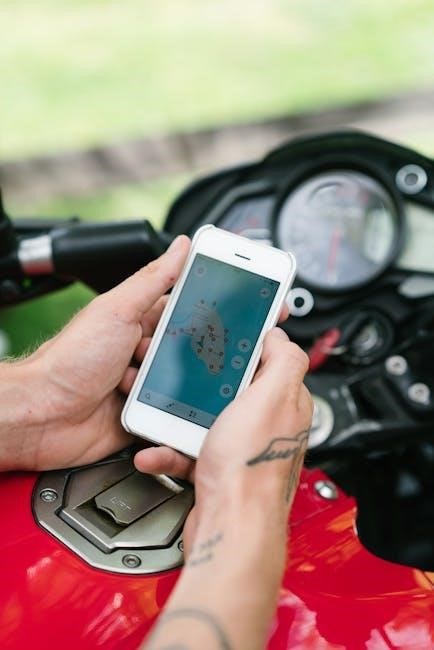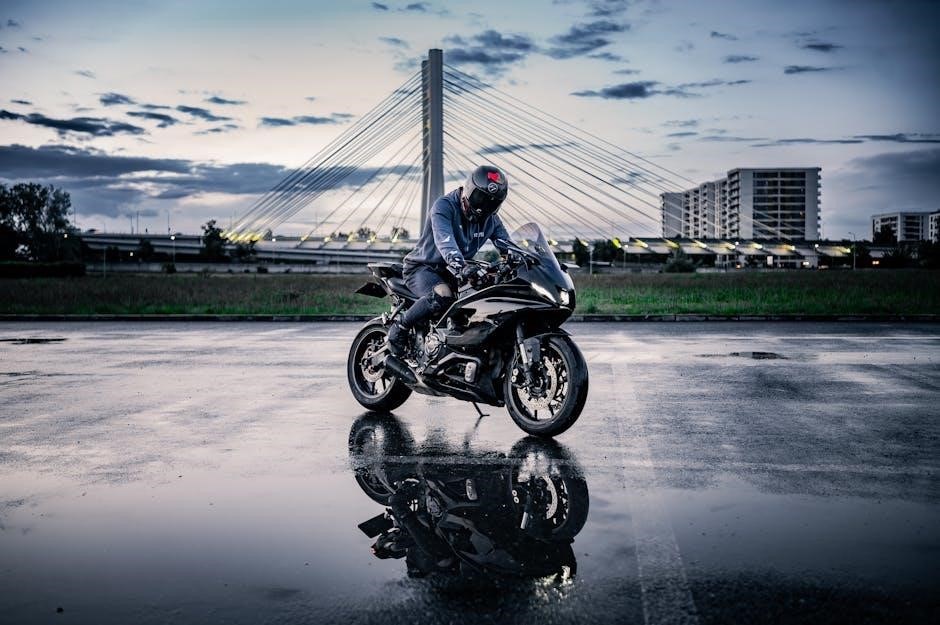guide to motorbikes
Motorbikes are versatile, two-wheeled vehicles designed for speed, agility, and efficiency, appealing to both daily commuters and adventure enthusiasts. Their rich history and evolving designs offer freedom and thrill.
What Are Motorbikes?
Motorbikes, also known as motorcycles, are two-wheeled motorized vehicles designed for transporting one or two riders. They combine an engine, transmission, and chassis, offering a unique blend of speed, agility, and efficiency. Available in various styles, motorbikes serve purposes ranging from daily commuting to adventure and racing. Their compact design allows for easy maneuverability, making them popular in urban and off-road environments. Whether for practicality or thrill-seeking, motorbikes embody freedom and versatility, appealing to a wide range of enthusiasts worldwide.
History and Evolution of Motorbikes
The history of motorbikes began in the late 19th century, with the first powered two-wheeler, the Hildebrand & Wolfmüller, introduced in 1894. Early motorbikes evolved from bicycles with added engines, offering a new form of personal transportation. By the early 20th century, brands like Harley-Davidson and Indian emerged, shaping the industry. Post-WWII, motorbikes gained popularity, with Japanese manufacturers like Honda leading innovation. Over decades, motorbikes evolved in design, technology, and performance, catering to diverse needs from commuting to racing, while maintaining their timeless appeal as symbols of freedom and adventure.

Types of Motorbikes
Motorbikes vary in design, purpose, and style, catering to diverse preferences. From cruisers to sports bikes, touring models, and off-road adventurers, each type offers a unique riding experience.
Cruiser Motorbikes
Cruiser motorbikes are designed for comfort and relaxed riding, often featuring low-slung seats and a laid-back riding position. They typically have powerful engines, chrome detailing, and a retro aesthetic. These bikes are ideal for long-distance touring or casual rides, emphasizing comfort over speed. Popular brands like Harley-Davidson and Indian Motorcycle are synonymous with this style. Cruisers often come with large fairings, windshields, and ample storage, making them perfect for travelers seeking a smooth, enjoyable journey.
Sports Bikes
Sports bikes are built for speed and agility, featuring lightweight frames, aerodynamic designs, and powerful engines. They are designed for thrill seekers, emphasizing performance and handling. These bikes often originate from racing heritage, with brands like Ducati and Yamaha offering iconic models. Sports bikes typically have a forward-leaning riding position, optimizing control at high speeds. They are ideal for experienced riders who prioritize speed and precision, making them a favorite among track enthusiasts and those chasing adrenaline on the road.
Touring Motorbikes
Touring motorbikes are designed for long-distance travel, offering comfort and practicality. Equipped with large fairings, comfortable seating, and ample storage, these bikes cater to riders seeking adventures across vast distances. They often feature upright riding positions, reducing fatigue on extended journeys. Popular among experienced riders, touring bikes like Harley-Davidson’s Electra Glide or BMW’s R 1250 RT provide the perfect blend of performance and comfort, making them ideal for exploring new destinations with ease and style.
Off-Road and Adventure Bikes
Off-road and adventure bikes are built for rugged terrains, offering durability and versatility. Designed with robust frames, high suspension, and knobby tires, these bikes excel in challenging environments like dirt trails and rough landscapes. They often feature lightweight materials and high-displacement engines, providing both power and agility. Adventure bikes, such as the BMW R 1250 GS, combine off-road capabilities with long-distance touring features, including ample storage and ergonomic designs. These bikes are perfect for riders seeking thrilling adventures beyond paved roads.

Choosing the Right Motorbike
Selecting the right motorbike involves considering your riding purpose, skill level, budget, and personal preferences. Ensure the bike suits your needs for commuting, touring, or off-road adventures effectively.
Factors to Consider When Selecting a Motorbike
When choosing a motorbike, consider your riding purpose, engine size, weight, and ergonomics. Assess your budget, including purchase price, insurance, and maintenance costs. Evaluate fuel efficiency for daily use and long trips. Safety features, such as ABS and traction control, are crucial. Test ride different models to ensure comfort and handling. Additionally, think about storage, availability of spare parts, and resale value. Your skill level and intended terrain, whether urban or off-road, will also influence the best choice for you.
Tips for First-Time Buyers
First-time motorbike buyers should start by test riding different models to find the best fit. Consider your budget, including insurance and maintenance costs. Prioritize reliability and lower mileage when purchasing used bikes. Research financing options and warranty offers. Avoid overspending on unnecessary accessories initially. Focus on safety by investing in proper gear. Take a motorcycle safety course to build confidence and skills. Start with a smaller engine size to gain experience before upgrading. Always negotiate the price and ensure a thorough inspection before finalizing the purchase.

Motorbike Safety
Motorbike safety is paramount, emphasizing visibility, protective gear, and defensive driving. Always wear helmets, gloves, and sturdy clothing to minimize injury risks and ensure rider protection on the road.

Essential Safety Gear
Protective gear is vital for motorbike safety. A helmet with a face shield or goggles protects the head and eyes. Durable gloves prevent hand injuries, while sturdy boots safeguard feet. A leather or armored jacket and pants provide abrasion resistance. Reflective clothing enhances visibility, and knee and elbow guards add extra protection. Ensuring all gear fits properly and meets safety standards is crucial for maximum protection in case of an accident or sudden impact while riding.
Riding Tips for Beginners
Start with proper posture: keep knees slightly bent, grip the handlebars firmly, and maintain balance. Accelerate gradually to avoid losing control. Brake smoothly, using both brakes evenly. Practice in open spaces before traffic. Take a motorcycle safety course to build confidence and skills. Always stay alert and anticipate potential hazards. Keep a safe distance from other vehicles and avoid distractions while riding. Regular practice helps improve coordination and reaction times, ensuring a safer and more enjoyable motorbike experience.
Maintenance and Care
Regular maintenance ensures optimal performance and longevity of your motorbike. Check oil, tires, brakes, and chain regularly. Clean and lubricate moving parts to prevent wear and tear effectively.
Regular Maintenance Checks
Regular maintenance is crucial for ensuring your motorbike runs smoothly and safely. Start with checking oil levels, tire pressure, and brake pads. Inspect the chain for tension and wear, and clean or lubricate it as needed. Battery health is another key area, ensuring terminals are clean and connections are secure. Additionally, check for any fluid leaks and test all lights and signals. A thorough inspection before each ride can prevent issues and extend the lifespan of your motorbike.
DIY Tips for Motorbike Maintenance
Performing regular DIY maintenance can keep your motorbike in top condition. Start by checking and topping up oil levels, ensuring the correct viscosity for your bike. Clean the air filter regularly to improve performance and fuel efficiency. Lubricate the chain every 500 miles, and tighten any loose bolts or fasteners. Inspect tires for wear and maintain proper pressure. Wash and wax the bike to protect the paint and metalwork. Finally, test the brakes and lights to ensure everything functions safely and efficiently.
Advanced Riding Skills
Mastering advanced techniques enhances safety and control. Focus on cornering, braking, and acceleration. Practice situational awareness and adaptive riding strategies to handle various road conditions confidently.
Mastering Cornering Techniques
Mastering cornering involves proper body positioning, braking, and throttle control. Shift weight slightly forward, keep knees gripping the tank, and look where you want to go. Brake before entering the turn, then accelerate smoothly. Avoid sudden movements and maintain balance. Practice in safe, open areas to build confidence. Smooth, deliberate actions ensure stability and control, making cornering safer and more enjoyable. Consistent practice in various conditions enhances skill and reduces risk.
Improving Braking and Acceleration
Improving braking and acceleration requires smooth, controlled inputs. Use both front and rear brakes progressively, avoiding sudden stops. Downshift before braking to reduce speed effectively. Accelerate gradually, especially when exiting turns, to maintain traction. Practice in a safe, open area to refine these skills. Consistent throttle control and proper gear usage enhance stability and performance. Regular practice builds muscle memory, ensuring safer and more efficient riding. Smooth transitions between braking and accelerating are key to mastering motorbike dynamics.

